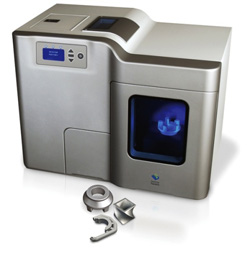 It's ultra-cool and they're coming to an online store near you. Here's an overview from TNW that we wanted to share:
It's ultra-cool and they're coming to an online store near you. Here's an overview from TNW that we wanted to share:
“Want to turn your creative thinking about objects into a reality? Of course you do. What if you could just magic up a new button for the one that fell off your favourite shirt? What if you could invent a new way for carrying hot items in the kitchen? What if?
The rise of 3D printing holds a lot of promise for those of us who can focus and visualise what we might make. The idea of the replicator might have sparked the imaginations of Star Trek viewers or the Maker with ‘base block’ (recycled or otherwise) from Warren Ellis’ Transmetropolitan series could point to a home unit that can take spoken commands to create almost anything. But we’re a long way from this future, for now.
3D printing might not be available in all homes yet, but the latest desk-top 3D printers being us one step closer to the possibility of manufacturing more things for ourselves.
The process is not an easy one still, but some are more optimistic than others when it comes to future possibilities. Chris Anderson, former editor of Wired magazine recently left his editorial position to take up the position as CEO at 3D Robotics. Though the $5million+ investment in the company led by Jon Callaghan of True Ventures and Bryce Roberts at O’Reilly AlphaTech Ventures probably helped a lot, it’s Anderson’s belief in people’s own power to manufacture things for themselves that appears to have spurred on his change in career.
Anderson’s book, “Makers” also came out recently. It outlines ways in which people are making products for themselves already and 3D printing plays a big part in the inspiration for more people to get involved.
It’s smart to get in while the industry is on the uptick, but 3D printing has been around for some time and there’s a long way to go before domestic users will be able to think of something and print it off.
Academic origins
It probably won’t come as a surprise to read that the term ’3D printing’ was coined at MIT. In 1995, grad students Tim Anderson and Jim Bredt hacked an inkjet printer to spew a binding solution onto powder to create 3D shapes. After a time, the experiments became a business and Bredt and Anderson founded Z Corporation which was acquired by 3D Systems in January this year.
That’s a lot of history to skip in one go, but the companies helping people print in three dimensions today are pushing the boundaries for heavy industry and small businesses to design and create some pretty amazing things.
Shapeways is a 3D printing startup that began as a spin off of Royal Philips Electronics in the Netherlands. It was established in 2007 by Peter Weijmarshausen, Robert Schouwenburg and Marleen Vogelaa who pushed things further through the Philips Lifestyle incubator.
In 2008 the company launched a service for customers to design their own 3D products by sending a computer aided design (CAD) file to the Shapeways website. Through this process, the startup has encouraged hundreds of designers and businesses to make things and sell them, as well as providing tutorials and generally working to democratize the manufacturing process.
Shapeways has since printed and sold more than a million user-created objects from the delightfully silly to the practical and extraordinarily beautiful. Everything from Minecraft figurines and the Internet’s own “F U Anteater” to an assortment of wedding rings and even mathematical shapes have been explored through the service.”

